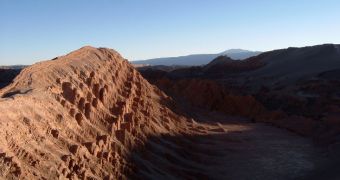Astronomers know numerous details about prospective targets for space exploration, such as for example the surface of Mars, but they cannot test technologies they want to send there directly. Fortunately, they had two deserts on Earth that they can use as analogs for those environments.
Readings collected by rovers, landers and orbiters that made their way to the Red Planet thus far indicate that its surface is very dry and cold, with sub-freezing temperatures representing the norm.
There are no locations on Earth that are perfect analogs for this type of environment, but the Upper Dry Valleys of Antarctica and the Atacama Desert in Chile provide perfect, individual matches for the most important traits of the Martian surface.
Numerous research teams are currently conducting investigations in these regions, intent on finding out more about the limits between which life can endure. This also helps them predict with greater certainty the chances of life existing on our neighboring planet as well.
The most important thing that needs to be established is whether life managed to evolve on Mars a couple of billion years ago, when conditions there were roughly similar to Earth's, and liquid water could endure on the open surface.
If that was the case, then it's conceivable that microbes or bacteria managed to adapt to the conditions today. This is evidenced by microorganisms on Earth, which survived in environments ranging from volcanic calderas and hydrothermal vents to glacial lakes buried under miles of ice.
Researchers from the Johns Hopkins University (JHU), in Baltimore, Maryland, led by associate professor of biology Jocelyne DiRuggiero, are now conducting studies on samples collected from the two locations, Daily Galaxy reports.
What they want to discover are the similarities between lifeforms that exist in these two areas. None of the two deserts has liquid water. Atacama sees rainfalls once every few years or so, whereas the Upper Dry Valleys only receives snow, which immediately freezes over.
“What we do in those environments is try to understand who is there, what those organisms might be doing, how they are distributed,' DiRuggiero explains. Another goal is establishing if the organisms were just brought there by the wind, or if they are really active metabolically.
“Right now the only parameter […] we have measured that differentiates the populations, Antarctica and the Atacama, is the temperature. [At both deserts,] the soils are very dry, the soils are very low in organics, they contain a fair amount of salt,” the expert adds.
“The big difference is the temperature. We don’t really know what it means yet,” she concludes.

 14 DAY TRIAL //
14 DAY TRIAL //